Cats
What Do Bombay Cats Eat?
Hungry for insights on what fuels Bombay cats' health? Discover the key to their well-being through a high-protein, grain-free diet.
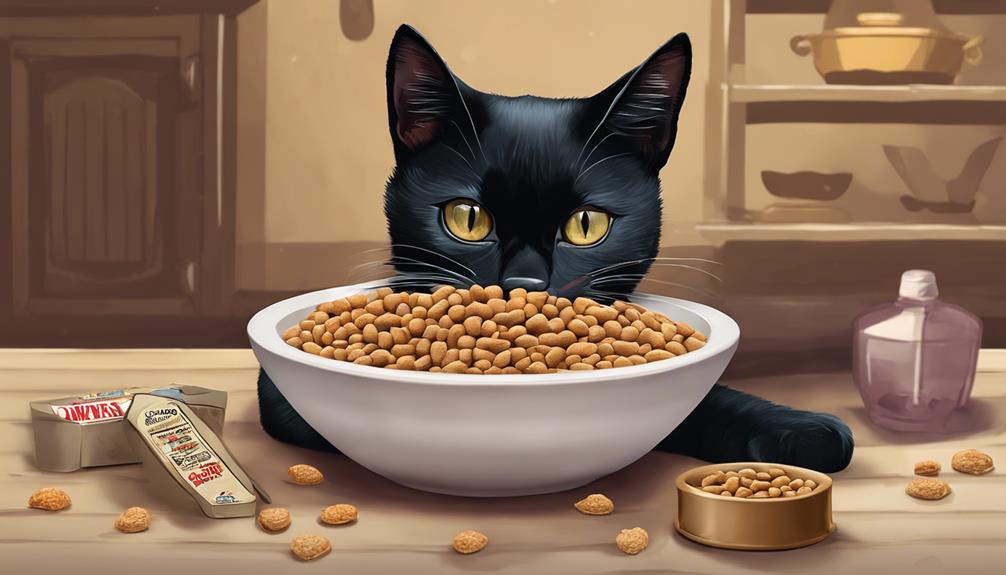
At peak health, Bombay cats thrive on a high-protein, grain-free diet. Wet food with lean proteins maintains their lean muscle mass and energy levels. Monitoring food intake is critically important in preventing obesity and ensuring overall health. Remember, fresh water availability is key for hydration and well-being. Treats should be limited to 10% of daily calories to maintain a balanced diet. Consulting a vet for personalized dietary recommendations is highly recommended. Stay tuned for further insights on tailored feeding plans and the importance of a balanced diet for Bombay cats' vitality and longevity.
Key Takeaways
- High-protein wet food with lean proteins is essential.
- Grain-free options support their dietary needs.
- Monitoring food intake is crucial for health.
- Brands like Untamed offer suitable food choices.
- Ensure a balanced diet for overall well-being.
Dietary Requirements for Bombay Cats
When caring for Bombay cats, it's vital to understand their specific dietary requirements. This breed thrives on a diet that's high in protein to meet their daily caloric needs and maintain lean muscles. Opting for wet food, especially grain-free options with lean proteins, is highly beneficial for guaranteeing that Bombay cats receive a nutritionally complete diet. Untamed's impact on Bombay cats can be positive when offering them high-protein, low-carb food choices.
To keep Bombay cats healthy and happy, it's essential to provide them with a balanced diet that supports their overall well-being. Monitoring their food intake is particularly important due to their dense build and susceptibility to obesity. By choosing food options that aren't only tasty but also meet their nutritional requirements, you can make sure that your Bombay cat stays in top shape. Remember, a well-fed Bombay is a content and thriving companion.
Protein-Rich Diet for Bombays
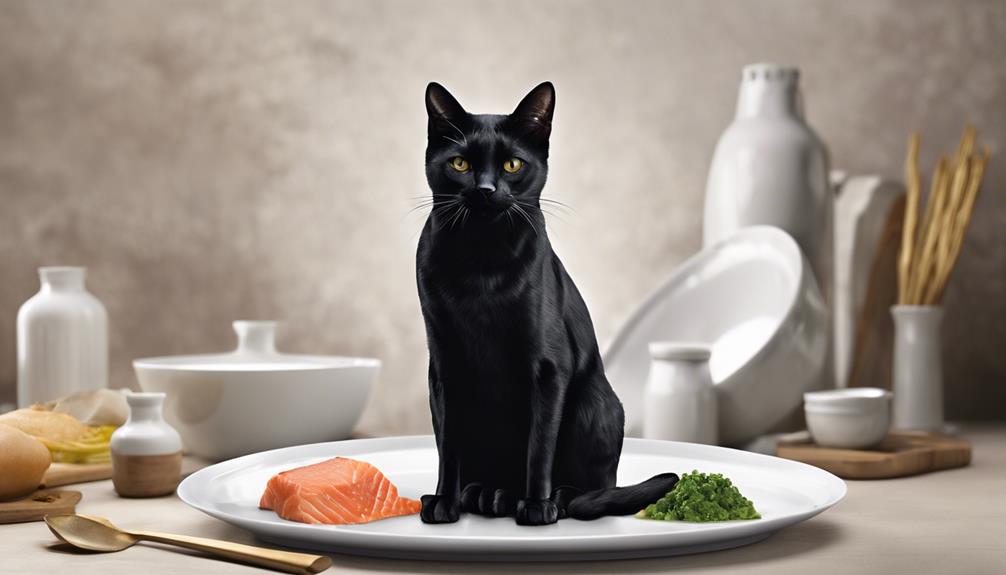
A protein-rich diet is essential for the peak health and well-being of Bombay cats. These sleek felines require a high-protein diet to meet their daily caloric needs and maintain lean muscle mass. Feeding them high-protein wet food, especially grain-free options with lean proteins, can greatly benefit their overall health. Brands like Untamed offer high-protein, low-carb food that can positively impact the energy levels and well-being of your Bombay cat.
Ensuring that your Bombay cat's diet consists of over 50% protein content is important for keeping them healthy and active. This protein-rich diet supports their growth, energy levels, and overall health. By providing a balanced diet rich in protein, you can help your Bombay cat thrive and maintain their sleek physique. Remember, nutrition plays an important role in the happiness and vitality of your beloved Bombay companion.
Ideal Food for Bombay Cats
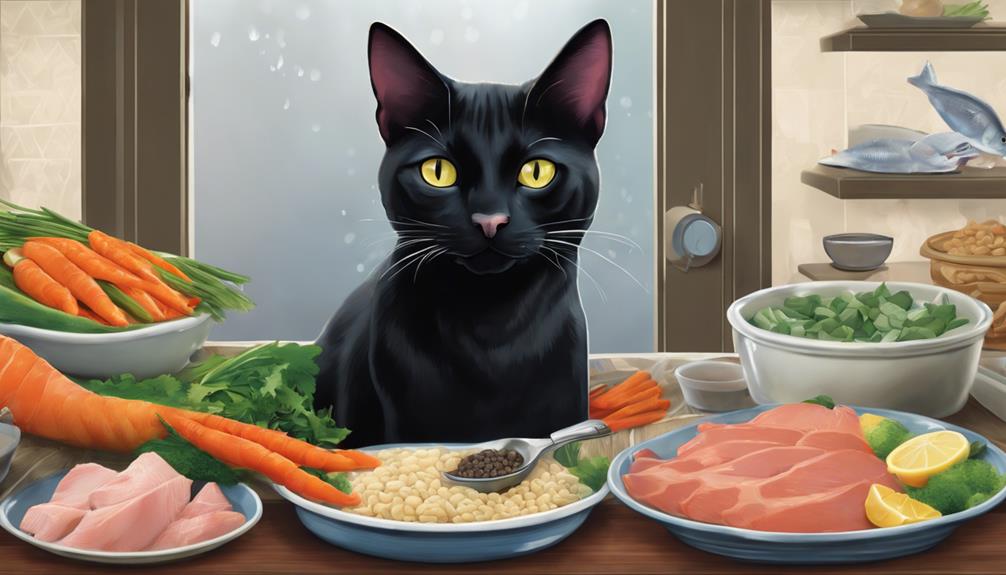
When it comes to selecting the perfect food for Bombay cats, it's important to think about nutritious diet choices that meet their dietary preferences.
By concentrating on high-protein, low-carb foods, you can offer health benefits that uphold their lean muscles and overall well-being.
Monitoring their food intake attentively is vital to prevent obesity and guarantee they sustain a healthy weight.
Nutritious Diet Options
For peak health and well-being, Bombay cats thrive on a high-protein diet to support their lean muscles and daily caloric requirements. The Bombay breed benefits greatly from wet food options, particularly grain-free varieties rich in lean proteins, promoting overall Cat Health.
Brands like Untamed offer high-protein, low-carb food that can positively impact Bombay cats' well-being. By providing a diet abundant in protein, you can help your Bombay cat maintain a healthy weight and support their longevity.
Dietary Preferences of Bombays
We consistently observe that Bombay cats exhibit a strong preference for a diet rich in high-quality protein content to support their overall health and well-being. When considering the dietary needs of your beloved Burmese cat, choosing a high-protein diet is essential. Grain-free wet food options, especially those with lean proteins, can be highly beneficial for meeting the nutritional requirements of Bombay cats. To illustrate the importance of a high-protein, low-carb diet, consider the impact Untamed's specialized food can have on your cat's health. Below is a table summarizing the dietary preferences of Bombay cats:
| Dietary Preferences of Bombay Cats |
|---|
| High-Protein Diet |
| Grain-Free Wet Food |
| Lean Proteins |
Health Benefits of Diet
To ensure excellent health for Bombay cats, focusing on a high-quality diet abundant in lean proteins is essential. A high-protein diet helps maintain lean muscles and meets their daily caloric needs, supporting their overall well-being.
Opting for wet food options, particularly grain-free ones with lean proteins, can greatly benefit Bombay cats' health. Brands like Untamed offer high-protein, low-carb food that can cater to the unique dietary requirements of Bombay cats, ensuring they receive ideal nutrition.
Avoid Toxic Foods for Bombays
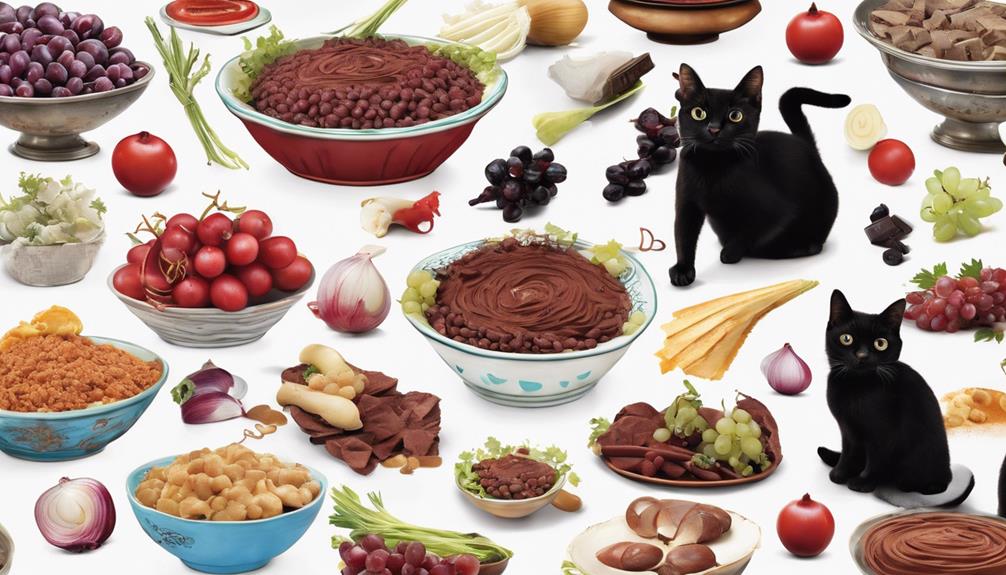
Let's talk about what foods to avoid giving your Bombay cat to keep them safe and healthy. Some harmful foods for Bombays include:
- Chocolate
- Caffeine
- Grapes
- Raisins
- Onions
- Garlic
- Xylitol
It's important to be mindful of these toxic ingredients in your cat's diet to prevent any potential health risks.
Harmful Foods for Bombays
Avoid feeding Bombay cats toxic foods like onions, garlic, grapes, and raisins, as these can be harmful to their health. Additionally, keep chocolate, caffeine, and alcohol away from them since these items are toxic and can lead to serious health issues.
Xylitol, an artificial sweetener commonly found in products, should be avoided in their diet as it can be dangerous for Bombay cats. Dairy products like milk and cheese should also be off-limits, as many cats are lactose intolerant and may experience digestive problems.
High-fat foods such as fried items or fatty meats should be avoided to prevent obesity and other health concerns in your Bombay cat. Remember, their well-being is our top priority.
Safe Diet Choices
When considering safe diet choices for Bombay cats, prioritizing a high-protein intake is essential to meet their caloric needs and maintain lean muscles. Opting for grain-free wet cat food that contains lean proteins can guarantee your Bombay cat receives the necessary nutrition for their well-being. Below is a helpful table outlining some safe diet choices for your Bombay feline friend:
| Category | Recommendations |
|---|---|
| Wet Food | Grain-free options with lean proteins |
| Dry Food | High-protein, low-carb choices |
| Special Diets | Consider Untamed's trial pack for customized meal boxes |
Choosing the right cat food is critical to support your Bombay cat's overall health, and a high-protein, grain-free diet can be advantageous for their vitality and happiness.
Fresh Water Availability
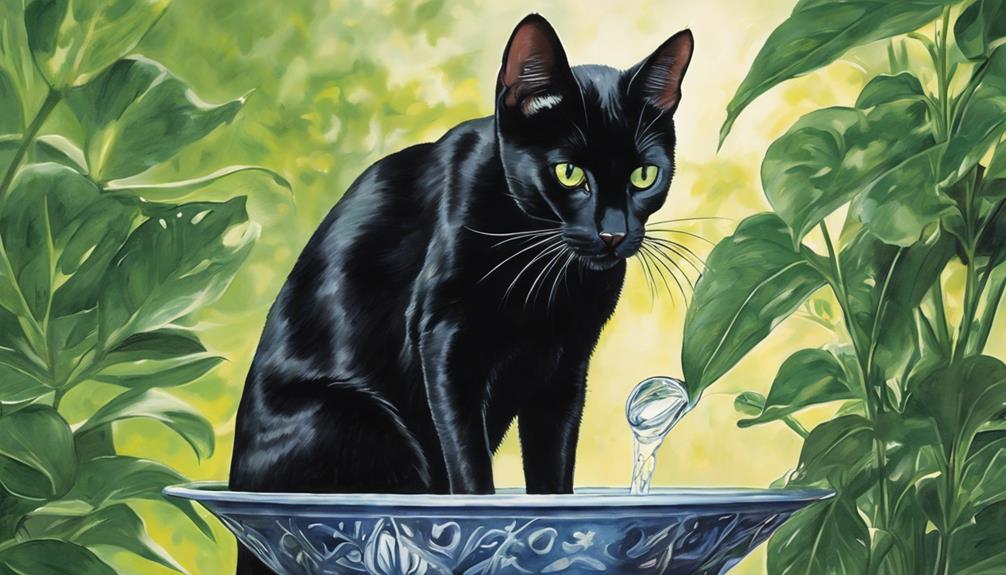
Guaranteeing a constant supply of fresh, clean water is essential for maintaining the health and hydration of Bombay cats. Hydration is vital to their overall well-being, aiding in digestion and kidney function.
To meet their water needs, it's important to provide a clean bowl of water that's refreshed regularly. Some Bombay cats may prefer running water, making a cat water fountain a valuable investment to encourage them to drink more.
Moderation in Treats for Bombays
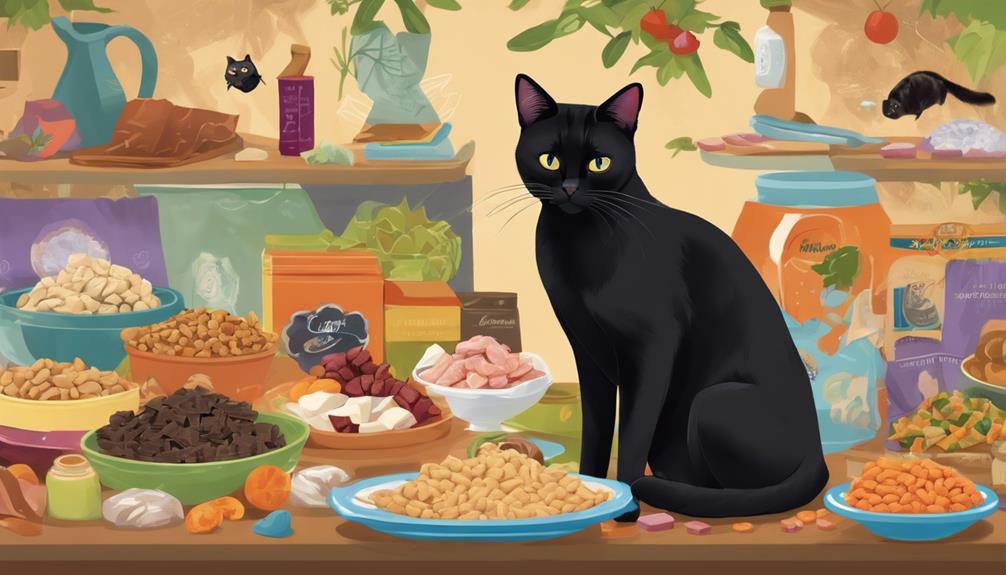
When it comes to treats for your Bombay cat, remember that moderation is key. Limiting treat intake to only 10% of their daily calories helps prevent weight gain and keeps them healthy.
Opt for nutritious options like freeze-dried meat or catnip, and use treats as rewards sparingly to maintain a balanced diet.
Treat Portion Control
To maintain a healthy diet for your Bombay cat, it's crucial to control treat portions by limiting them to 10% of their daily caloric intake. Overindulging in treats can lead to weight gain, which may impact your cat's overall health.
It's important to be mindful of the number of treats given to your Bombay to prevent excessive calorie intake. Treats should be used sparingly, such as for training sessions or occasional rewards, to avoid disrupting their balanced diet.
Keep a close eye on your Bombay cat's weight to guarantee they stay within a healthy range, adjusting treat portions accordingly. By practicing moderation in treat-giving, you can help your Bombay maintain a healthy weight and enjoy a well-rounded diet.
Healthy Treat Options
In choosing healthy treat options for your Bombay cat, it's important to prioritize moderation to prevent weight gain and maintain a balanced diet. Healthy treat options such as freeze-dried meat treats, cooked chicken or fish pieces, and catnip-infused treats can be great choices. It's vital to remember that treats should only make up a small part of your cat's daily calorie intake, ideally staying below 10%.
Additionally, it's important to avoid feeding your Bombay cat human foods like chocolate, grapes, and onions, as they can be toxic to cats. By offering your Bombay cat these healthy treat options in moderation, you can't only reward and bond with them but also promote good behavior and overall health.
Importance of Consulting a Veterinarian
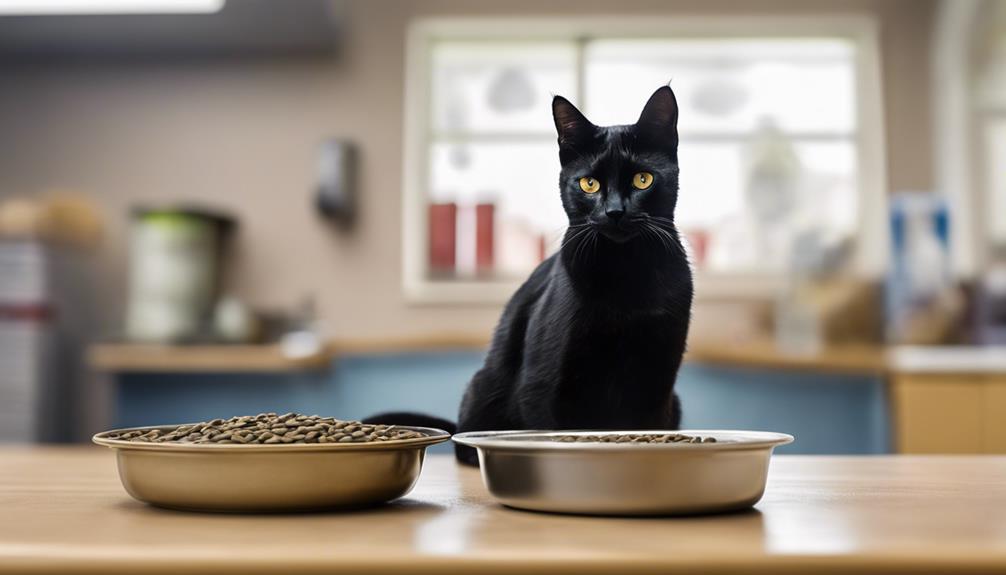
Engaging with a veterinarian is crucial for customizing a Bombay cat's diet to their specific needs. Your vet can provide personalized dietary recommendations based on factors like age, weight, and overall health. These tailored suggestions guarantee that your Bombay cat receives the necessary nutrients for peak well-being.
Furthermore, veterinarians can recommend high-quality cat food brands that are appropriate for Bombay cats, enhancing their overall health. Regular consultations with your vet are essential for monitoring your cat's evolving dietary requirements as they age.
Additionally, your vet can offer guidance on shifting your Bombay cat to new diets if needed, addressing any allergies or sensitivities they may have. By collaborating with a veterinarian, you can make certain that your beloved cat's nutritional needs are met, supporting their longevity and quality of life.
Feeding Plan for Bombay Cats
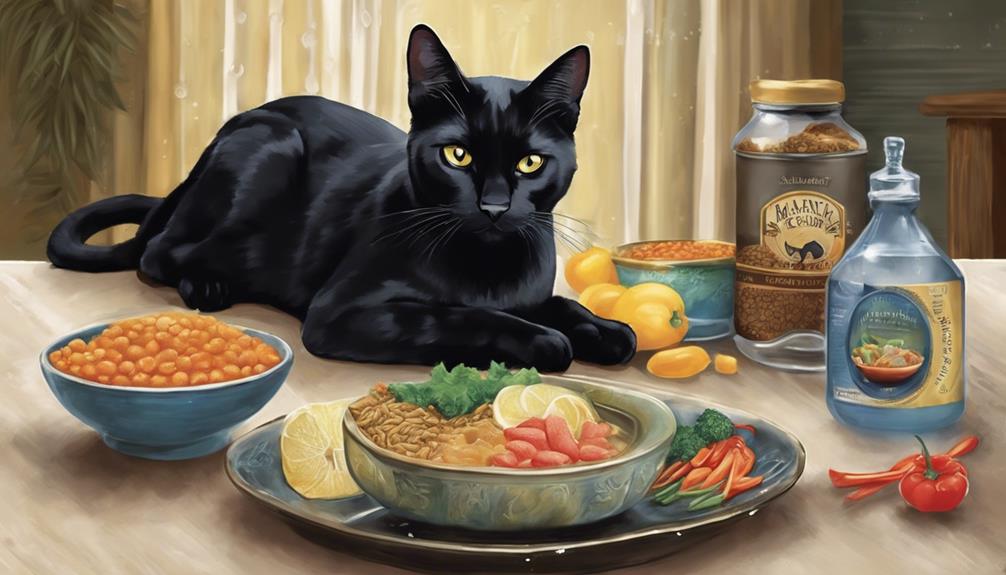
When planning the feeding schedule for Bombay cats, it's important to take into account their dietary requirements for best health.
High-protein meals and a consistent meal schedule are key factors to keep in mind.
Monitoring their food intake can help manage their weight and guarantee they stay healthy and active.
Dietary Requirements for Bombays
With their unique dietary needs in mind, Bombay cats thrive on a high-protein feeding plan to support their lean muscles and overall health. When it comes to feeding your Bombay cat, opt for wet food options that are rich in lean proteins. These choices help meet their caloric requirements while aiding in muscle maintenance.
A high-protein diet not only fuels your Bombay's active lifestyle but also contributes to their overall well-being. Untamed's influence on Bombay cats can be positively impacted by incorporating a diet that's high in protein and low in carbs.
Meal Schedule Suggestions
To guarantee peak health and well-being for your Bombay cat, establishing a consistent meal schedule is essential. Here are some meal schedule suggestions for your furry friend:
- Set Scheduled Meal Times: Make sure you feed your Bombay cat at the same times each day to create a routine they can rely on.
- Feed Twice Daily: Providing two meals a day with measured portions helps prevent overeating and maintains a healthy weight.
- Balanced Diet: Offer high-quality cat food to meet their nutritional needs and support overall health.
- Consult with a Vet: Work with a veterinarian to determine the right portion sizes based on your cat's age, weight, and activity level.
Balanced Nutrition for Bombays
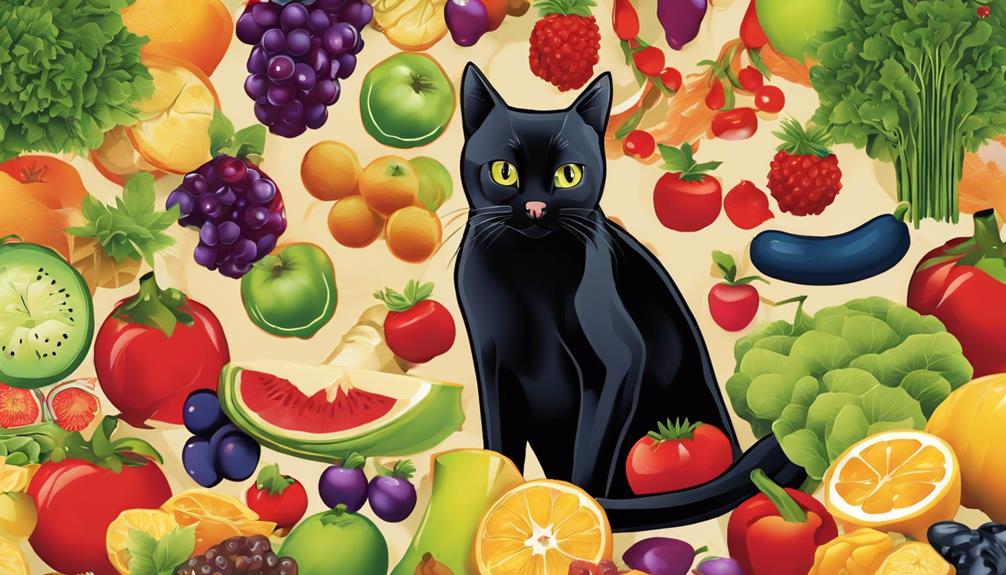
Ensuring balanced nutrition is essential for the health and wellbeing of Bombay cats. These sleek and muscular felines require a diet rich in protein to support their active lifestyle and maintain lean muscles. Feeding them grain-free wet food containing lean proteins can greatly benefit their overall health. Consider opting for high-protein, low-carb options like Untamed to provide the necessary nutrients for your Bombay's wellbeing. It's important to monitor their food intake carefully due to their dense build, as overfeeding can lead to obesity, impacting their health negatively. Providing a nutritionally balanced diet is necessary for the longevity and vitality of Bombay cats. Let's take a closer look at some key components of a balanced diet for your Bombay cat:
| Key Component | Description |
|---|---|
| High Protein | Supports muscle health and energy levels. |
| Lean Proteins | Promote lean muscle mass and overall health. |
| Grain-Free | Helps prevent digestive issues and supports a healthy coat. |
| Balanced Nutrients | Provides essential vitamins and minerals for overall wellbeing. |
| Controlled Portions | Prevents overeating and maintains a healthy weight. |
Best Foods for Bombay Cats
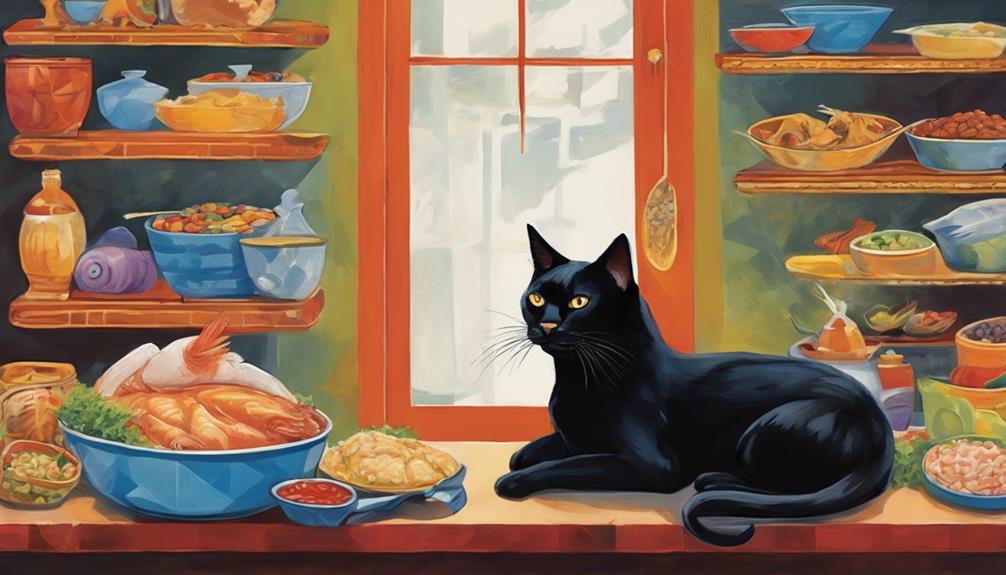
For Bombay cats, prioritizing high-protein diets is key to supporting their lean muscles and daily caloric needs. When selecting cat food for your Bombay, opt for options rich in protein to keep them healthy and active.
Here are some of the best foods for Bombay cats:
- Wet Food: Consider incorporating wet food into your Bombay cat's diet, especially grain-free varieties with lean proteins. This can provide essential hydration and nutrients important for their well-being.
- Untamed's High-Protein, Low-Carb Food: Feed your Bombay cat specialized high-protein, low-carb food like Untamed's formula to make sure they receive the necessary nutrients for excellent health.
- Monitor Food Intake: Due to their dense build, closely monitor your Bombay cat's food intake. This helps prevent overeating and obesity, ensuring they maintain a healthy weight.
- Balanced Nutrition: Providing a balanced diet with proper nutrition is essential for the overall health and well-being of Bombay cats. Ensure their meals are well-rounded and meet their dietary requirements for a happy and healthy feline friend.
Preventing Weight Gain in Bombays
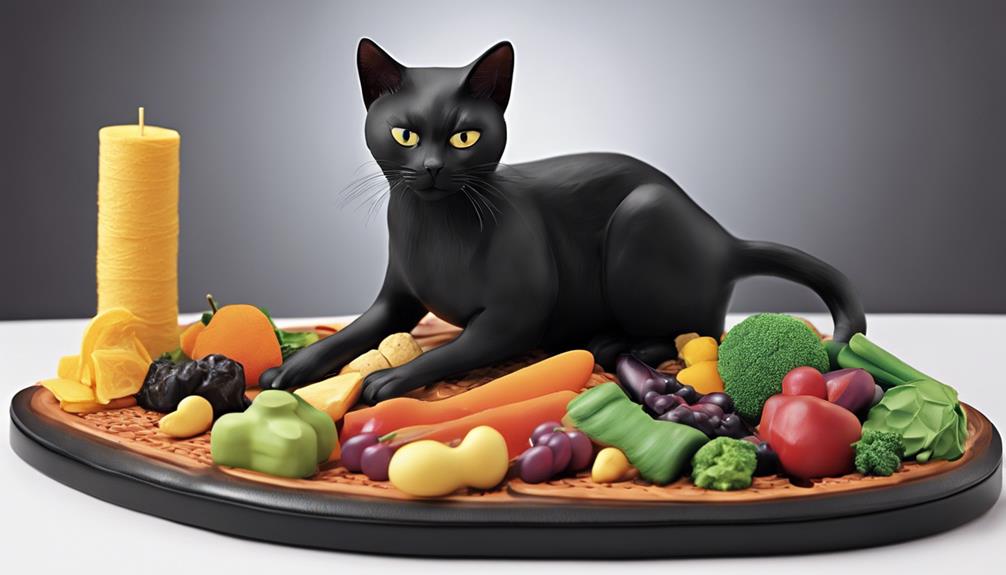
After discussing the best foods for Bombay cats, let's now address how to prevent weight gain in these felines. Bombay cats require a high-protein diet to maintain lean muscle mass and avoid excess weight. Monitoring their food intake is vital due to their dense build and susceptibility to obesity. Opt for specialized formulas like Purina Cat Chow Adult Healthy Weight to help manage weight in Bombays effectively.
To prevent weight gain in Bombay cats, it's imperative to provide proper nutrition tailored to their needs. Avoid free grazing and instead establish a feeding routine that suits your cat's size, age, and activity level. Adjust food amounts accordingly to prevent overeating and maintain a healthy weight. By prioritizing a high-protein diet and monitoring their food intake, you can help your Bombay cat stay fit and healthy for years to come.
Feeding Guidelines for Bombay Cats
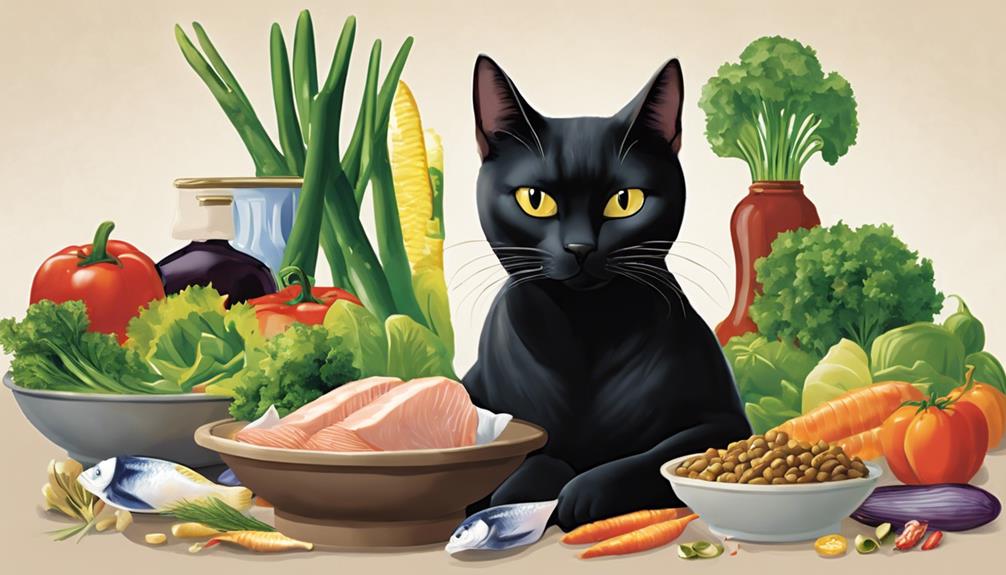
Feeding Bombay cats a high-protein diet is essential to meet their daily caloric needs and maintain lean muscle mass. When considering the dietary requirements of these sleek felines, it's important to pay close attention to their food intake to make certain they stay healthy and fit. Here are some feeding guidelines for your Bombay cat:
- Opt for wet food options: Consider grain-free wet foods with lean proteins to support your Bombay's high-protein diet needs.
- Choose high-quality brands: Brands like Untamed offer high-protein, low-carb options that can benefit your Bombay cat's overall health.
- Monitor portion sizes: Due to their dense build and potential for obesity, it's important to regulate the amount of food your Bombay consumes.
- Ensure proper nutrition: Providing your Bombay cat with the right balance of nutrients is key to helping them maintain a healthy weight and overall well-being.
Nutritional Needs of Bombay Cats
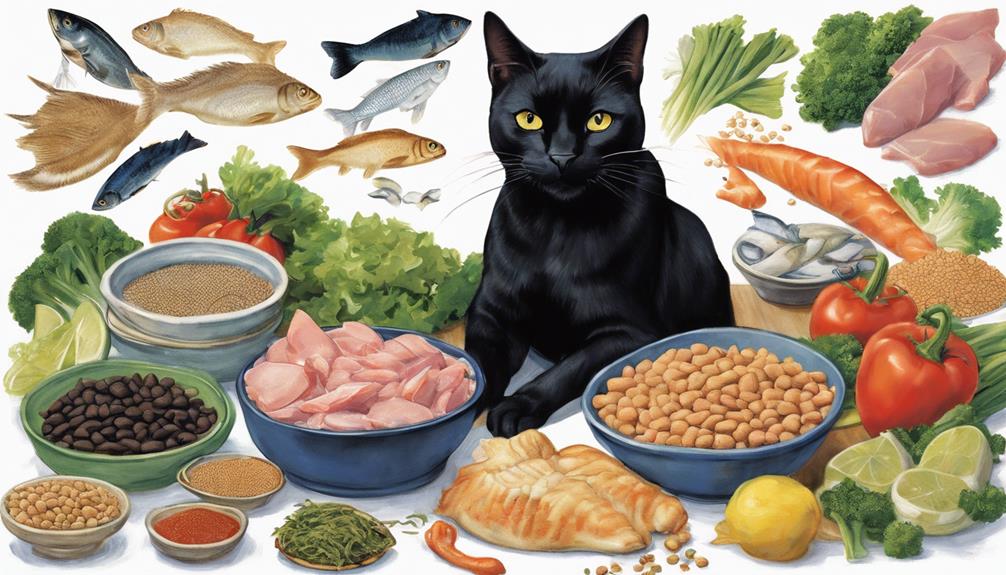
When considering the nutritional needs of Bombay cats, a key-protein diet is essential to support their daily caloric requirements and maintain their lean muscle mass. Bombay cats thrive on wet food options, especially those that are grain-free and packed with lean proteins. These choices not only cater to their dietary needs but also contribute to their overall well-being. Brands like Untamed play a critical role in offering high-protein, low-carb food that can greatly impact the health of Bombay cats.
Ensuring that Bombay cats receive the necessary nutrients through their diet is fundamental in helping them maintain a healthy weight and optimal health. A balanced diet not only supports their physical health but also enhances their vitality and longevity. By incorporating a high-protein diet with quality wet food options, Bombay cat owners can provide their feline companions with the nutrition they need to thrive.
Tailored Feeding Plan for Bombays

To cater to the specific dietary needs of Bombay cats, a customized feeding plan tailored to their high-protein requirements is essential for their overall well-being and vitality. When considering a tailored feeding plan for Bombays, there are a few key factors to keep in mind:
- Breed-specific nutrition: Bombay cats benefit from diets rich in high-quality proteins to support their lean muscle mass and energy levels.
- High-protein diet: Making sure that the food provided is high in protein is critical for meeting the daily caloric needs of Bombay cats and keeping them healthy.
- Meal boxes: Customized meal boxes, such as those offered by Untamed, can help simplify feeding routines and make certain that Bombay cats receive the necessary nutrients.
- Balanced meals: It's important to provide a well-rounded diet that includes a mix of proteins, fats, and carbohydrates to support the overall health of Bombay cats.
Health Benefits of Proper Nutrition
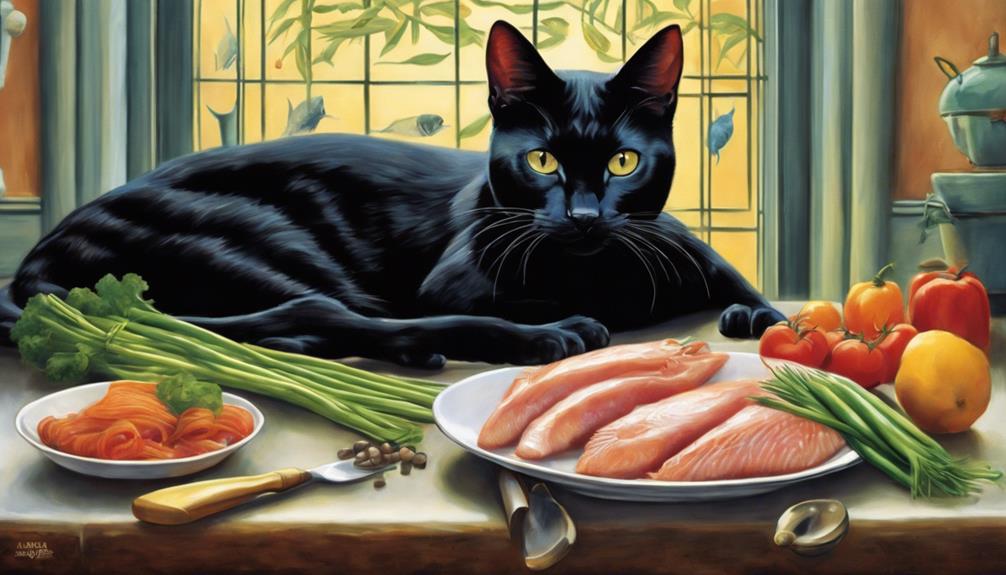
Improving overall well-being and vitality, proper nutrition plays a pivotal role in supporting the health of Bombay cats. Just like us, what we eat greatly impacts our health, and the same goes for our feline friends. A balanced diet not only helps prevent obesity, a common issue in Bombay cats, but also supports lean muscle development. High-protein food is essential to meet the caloric needs of active Bombay cats, keeping them energized and healthy. Additionally, providing nutritionally balanced meals can contribute to their longevity and vitality, ensuring they lead happy and healthy lives.
When it comes to our Bombay cats, their nutrition is vital for maintaining strong teeth and overall well-being. Quality nutrition can help keep their teeth healthy and strong, preventing dental issues that can cause discomfort. By feeding them a diet tailored to their needs, we can make sure that they receive the necessary nutrients to support their dental health and overall vitality. Remember, a well-fed cat is a happy cat!
Frequently Asked Questions
How Often Should You Feed a Bombay Cat?
We feed our Bombay cat multiple small meals daily to keep them healthy and satisfied. Consistency in feeding times helps support their well-being. Our furry friend thrives on a high-protein diet, maintaining lean muscles and a happy disposition.
What Do Bombay Cats Like?
We can tell you what Bombay cats like – it's all about high-protein, grain-free, wet food with lean proteins for their daily needs. This kind of diet keeps them happy and healthy!
Do Bombay Cats Like to Be Picked Up?
We've found that Bombay cats' preferences for being picked up vary. Observing body language and reactions is key. Proper handling techniques and building trust through gentle interactions help them feel more at ease with being held.
How Do You Make a Bombay Cat Happy?
To make a Bombay cat content, we guarantee they have a stimulating environment, plenty of playtime, cozy spaces, and regular grooming. Bonding through cuddling, petting, and interactive play solidifies our connection and contributes to their overall happiness.
Conclusion
In summary, ensuring your Bombay cat has a well-balanced diet is essential for their overall health and well-being. By providing them with a protein-rich diet, avoiding toxic foods, and ensuring fresh water availability, you can help them thrive.
Have you considered tailoring a feeding plan to meet the unique nutritional needs of your Bombay cat? Remember, proper nutrition plays a key role in maintaining their health and happiness.
Paul’s love for animals knows no bounds. As a dedicated writer and animal lover, Paul brings a unique perspective to our team. His firsthand experiences with various animals enrich our content and provide valuable insights into their behavior and needs. Whether he’s sharing tips for pet care or shedding light on pressing conservation issues, Paul’s passion for animals shines through in everything he does.

When it comes to keeping indoor cats happy and active, the best toys include Interactive Cat Kickers, offering hugging and wrestling fun with catnip; Variety Cat Toy Sets for diverse play; Electronic Interactive Toys for modern playtime and strengthening bonds; Catnip Favorites like Yeowww! Catnip Banana; and Engaging Feather Wands for satisfying hunting instincts. These toys provide mental stimulation, exercise, and entertainment. Your furry friend's playtime will reach new levels with these engaging options.
Key Takeaways
- Interactive cat kickers fulfill natural hunting instincts and promote physical activity indoors.
- Variety toy sets offer diverse play options, stimulating indoor cats for hours of entertainment.
- Electronic interactive toys revolutionize playtime by stimulating hunting instincts safely.
- Catnip favorites like Yeowww! Catnip Banana Toy entice play and add excitement.
- Engaging feather wands are essential for satisfying hunting instincts and promoting exercise and bonding.
Interactive Cat Kickers
Interactive Cat Kickers are a popular choice for engaging indoor cats in active play and exercise. These long, plush toys are designed for cats to hug, kick, and wrestle with, providing a stimulating outlet for their energy.
Filled with catnip, Cat Kickers entice cats to play, keeping them entertained and mentally engaged. Not only do these toys fulfill a cat's natural hunting instincts, but they also promote physical activity, helping indoor cats stay fit and healthy.
The durability of Cat Kickers ensures that they can withstand rough play, making them a safe option for interactive fun. Whether your cat prefers a smaller or larger size, there are various designs to suit different preferences and play styles.
Variety Cat Toy Sets

When looking to provide indoor cats with a diverse range of play options, variety cat toy sets like the Chaser 6-Pack offer a convenient solution. These sets, such as the Taffy Rolls by Hauspanther and Silvervine Sardines by Twin Critters, provide interactive and engaging toys designed to stimulate indoor cats. The Chaser 6-Pack, known for its affordability, is tailored to keep your feline friend entertained for hours on end. Indoor cats thrive on variety and stimulation, making these cat toy sets an excellent choice for their well-being.
Whether it's the crinkle of the Taffy Rolls or the silvervine-infused fun of the Silvervine Sardines, these toy sets cater to your indoor cat's need for engaging playtime. By offering a mix of textures, sounds, and shapes, these sets keep your furry companion mentally and physically active. Investing in variety cat toy sets isn't only beneficial for your cat's health but also adds excitement to their indoor environment, ensuring they lead a happy and fulfilling life.
Electronic Interactive Toys
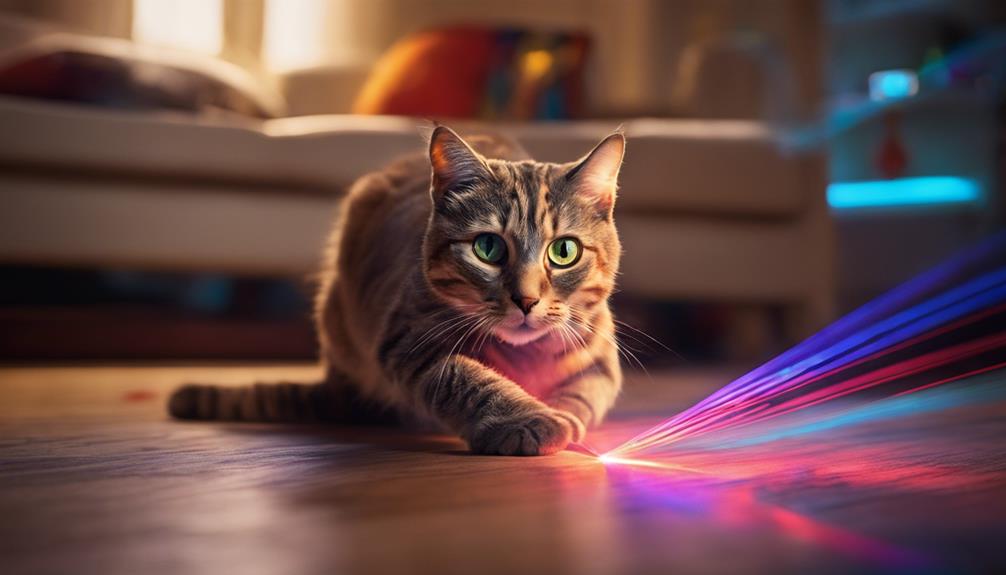
Have you ever considered how electronic interactive toys can revolutionize playtime for indoor cats? Electronic toys like the Petlinks Mystery Motion Cat Toy and the SmartyKat Hot Pursuit Electronic Motion Cat Toy are designed to tap into felines' instincts to chase and hunt. These toys provide various speed options and mimic real-life prey motions, keeping your cat engaged and entertained for hours. The PetFusion Ambush Interactive Cat Toy and the Frisco Peek-a-Boo Mouse Hunt Cat Toy offer rotating feather toys and peek-a-boo features, stimulating your cat's hunting instincts in a safe and interactive way. If you're looking for a more hands-on approach, the Ethical Pet Laser Exerciser is a compact laser pointer that provides exercise for your indoor cat while strengthening the bond between you and your feline friend. Embrace the world of electronic interactive toys to keep your indoor cat physically and mentally active.
| Electronic Interactive Toys | Description |
|---|---|
| Cat Tracks Butterfly | Mimics real-life prey motion for engaging play |
| Mystery Motion Electronic Motion | Offers multiple speed options to keep cats entertained |
| Hot Pursuit Electronic Motion | Stimulates hunting instincts with different speed settings |
Catnip Favorites

Exploring catnip favorites, we uncover a world of toys infused with nepetalactone, a compound that excites cats and promotes playful behavior.
The Yeowww! Catnip Banana Cat Toy stands out for its clever design, larger size, and being proudly made in the USA.
Cats go wild for the Potaroma Catnip Wall Toy, which can even perk up standoffish felines and encourage delightful licking behavior.
If you're looking for durable and eco-friendly options, the Hepper Catnip Stick Toys are filled with 100% organic catnip and come in beautiful pastel colors that will surely catch your cat's eye.
For a stimulating play experience, consider the Yeowww! Catnip Sardines, a favorite among our feline friends. These catnip toys not only stimulate playful behavior but also provide long-lasting fun.
With so many options infused with organic catnip to choose from, your indoor cat is sure to have a blast with these engaging and durable toys.
Engaging Feather Wands

Feather wands, interactive toys that mimic prey movements, are essential for satisfying cats' hunting instincts and promoting exercise, bonding, and mental stimulation in indoor cats. These toys come in various designs, lengths, and materials, catering to different play preferences. Lightweight and easy to use, feather wands encourage cats to jump, pounce, and chase, keeping them active and engaged.
| Designs | Lengths | Materials |
|---|---|---|
| Bird feathers | 12 inches | Plastic |
| Furry tails | 18 inches | Wood |
| Glittery | 24 inches | String |
Versatile and suitable for cats of all ages and activity levels, engaging feather wands provide a fun way for indoor cats to release energy and stay mentally sharp. Whether your feline friend prefers bird feathers, furry tails, or glittery attachments, there's a feather wand out there to keep them entertained for hours on end.
Frequently Asked Questions
What Is the Best Indoor Entertainment for Cats?
We believe interactive toys like the Petlinks Mystery Motion Cat Toy or catnip toys like the Yeowww! Catnip Banana Cat Toy can provide engaging entertainment for indoor cats. Adding accessory items like the KiTiFISH Feather Accessory enhances playtime.
How Do I Keep My Cat Entertained in the House?
We keep our indoor cats entertained by providing a variety of interactive toys, rotating them regularly to prevent boredom, setting up climbing structures, and using puzzle feeders. These activities engage their hunting instincts and keep them mentally stimulated.
What Cat Toys Do Cats Actually Like?
We love toys that mimic prey movements, like feather wand toys. Interactive toys, such as laser pointers, keep us engaged. Catnip-infused toys are irresistible. Scratching posts cater to our natural instincts. Variety in toys keeps us entertained and mentally stimulated.
How Do You Keep an Indoor Cat Stimulated?
To keep indoor cats stimulated, we engage them with interactive toys, puzzles, and vertical spaces. We rotate toys often and introduce new ones to prevent boredom. Catnip-infused toys, scratching posts, and feeding games are essential for their well-being.
Conclusion
In conclusion, finding the best toys for your indoor cat can bring joy and entertainment to both you and your feline friend.
From interactive kickers to electronic toys, there are plenty of options to keep your cat active and engaged.
So, don't hesitate to spoil your furry companion with some new toys that will provide endless fun and stimulation.
Your cat will thank you with purrs and playful antics that will surely warm your heart.
Paul’s love for animals knows no bounds. As a dedicated writer and animal lover, Paul brings a unique perspective to our team. His firsthand experiences with various animals enrich our content and provide valuable insights into their behavior and needs. Whether he’s sharing tips for pet care or shedding light on pressing conservation issues, Paul’s passion for animals shines through in everything he does.
Cats
Understanding and Addressing My Cat Panting While Playing
Curious about why your cat pants while playing?
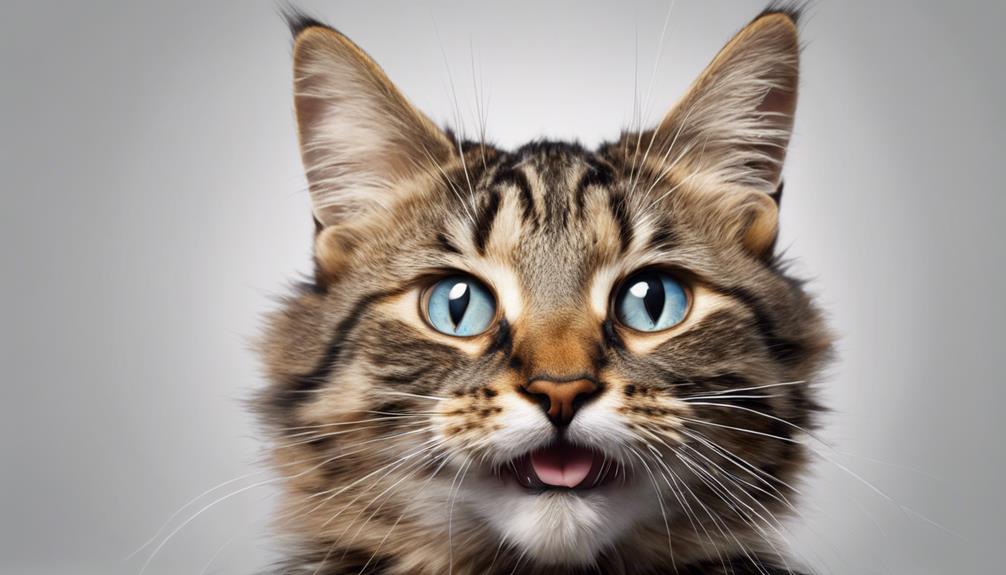
Cat panting while playing may signal excitement, heat regulation, or even anxiety. Keep an eye out for open-mouth breathing, rapid breaths, and excessive tongue protrusion. Ensure your furball has time to cool down and rest during vigorous play sessions. Pay attention to body temperature, energy levels, and signs of fatigue. Create a calm play environment to reduce stress-induced panting. If panting persists or appears excessive, seek veterinary care promptly to rule out health issues. Providing breaks, monitoring breathing, and offering rest periods during play can help manage panting. Proper care and observation are key to a healthy, happy cat.
Key Takeaways
- Monitor your cat's breathing patterns during play for signs of excessive panting.
- Provide frequent breaks to allow your cat to rest and recover during playtime.
- Ensure a cool and comfortable play environment to prevent overheating and excessive panting.
- Watch for any unusual behaviors or signs of distress while playing with your cat.
- Seek veterinary care if your cat continues to pant excessively or shows other concerning symptoms.
Signs of Panting in Cats
When cats pant during play, they exhibit signs such as open-mouth breathing, rapid breaths, and tongue protrusion. It's essential to monitor these signals closely to ensure our feline friends are comfortable and safe during their playful moments.
Panting in cats, especially after a vigorous play session, is a natural way for them to regulate their body temperature and catch their breath. By keeping an eye on the duration and intensity of panting episodes, we can gauge if our cats are enjoying themselves or if they might need a break.
Understanding these signs allows us to create a cool and calm environment post-play, aiding our cats in recovering smoothly from their panting episodes. By being attentive to these subtle cues and responding accordingly, we can ensure that our cats have a joyful and comfortable playtime experience.
Let's pay attention to the signs our cats show us, as they communicate their needs even when they can't speak.
Common Causes of Cat Panting
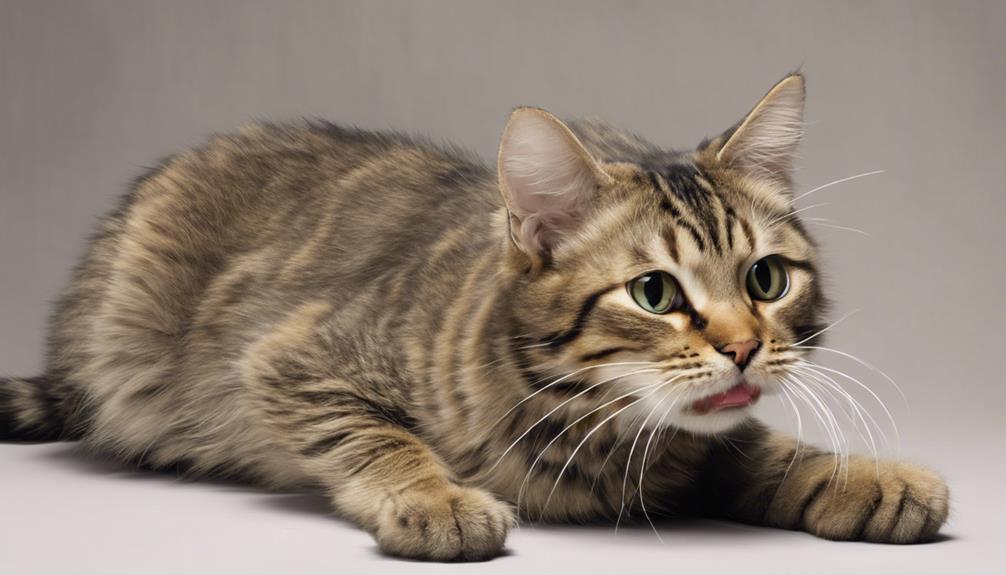
After observing the signs of panting in cats during play, it's important to understand the common causes of this behavior. Cats may pant while playing due to excitement and increased physical activity. When our feline friends engage in vigorous play sessions, their bodies heat up, and panting helps regulate their temperature.
Just like us after a workout, cats pant to cool down when they exert themselves during play. The combination of increased heart rate and rapid breathing during these active moments can lead to panting in cats. It's a natural response to the physical demands of playtime.
While panting during play is generally normal, it's essential to keep an eye on our cats. Prolonged or excessive panting could signal an underlying issue that may require veterinary attention. Understanding why our cats pant while playing allows us to better care for them and ensure they're happy and healthy during their playful adventures.
Impact of Exercise on Cat Panting
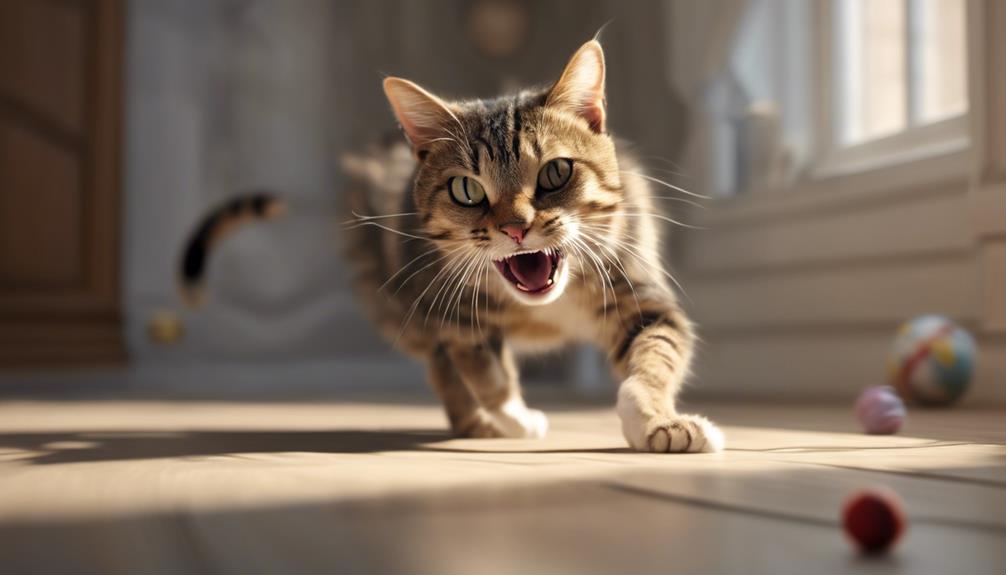
Engaging in physical activity can significantly impact a cat's panting behavior during play. When our furry friends exercise, they naturally regulate their body temperature through panting. This panting helps them cool down and catch their breath, much like how we might sweat during a workout. It's common for cats to pant after play sessions, and this should gradually subside as they rest and recover.
To prevent overexertion, it's essential to monitor your cat's energy levels during play. Watch for signs of excessive panting or fatigue, as this could indicate that they need a break. After exercise, ensure your cat has access to a cool environment and fresh water to aid in their recovery. This post-play cool down period is crucial for helping your cat return to a comfortable body temperature and recharge for their next adventure. Remember, a balance of exercise and rest is key to keeping your feline friend happy and healthy.
Recognizing Heat-Related Panting
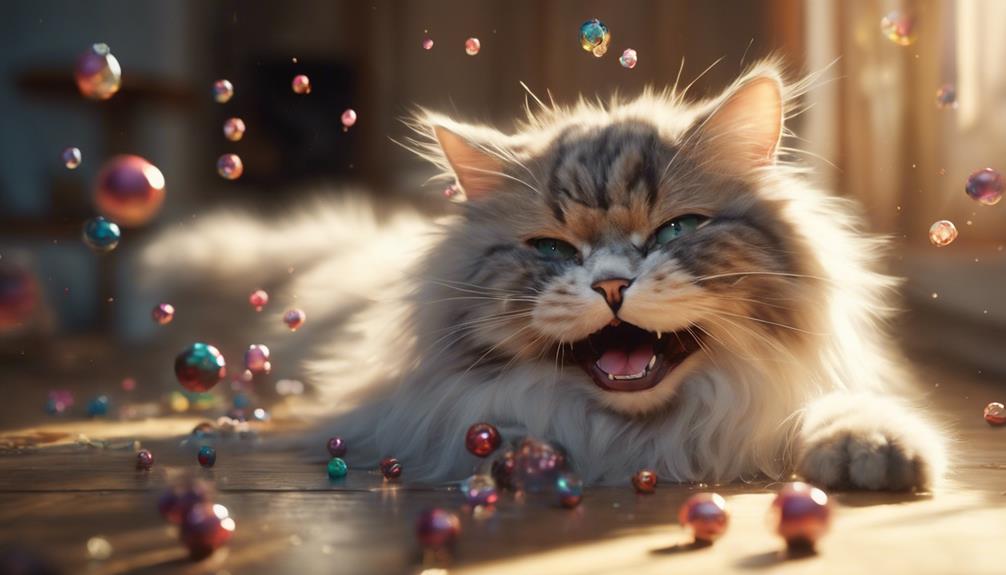
During play, cats may pant to regulate their body temperature in response to heat. Heat-related panting is a natural way for cats to cool down when they start feeling too warm. When you notice your cat panting excessively, it could be a sign that they're struggling to maintain a comfortable body temperature in a hot environment.
Cats may also exhibit behaviors like seeking shade, grooming themselves more frequently, or lying on cool surfaces to help regulate their body temperature.
It's crucial to keep a close eye on your cat during playtime, especially in hot weather, to prevent heat-related issues like heatstroke. Signs of heatstroke in cats include rapid breathing, lethargy, and excessive drooling. If you suspect your cat is experiencing heatstroke, it's essential to provide them with a cool, quiet space to relax and seek immediate veterinary attention to ensure their well-being.
Addressing Anxiety-Induced Panting
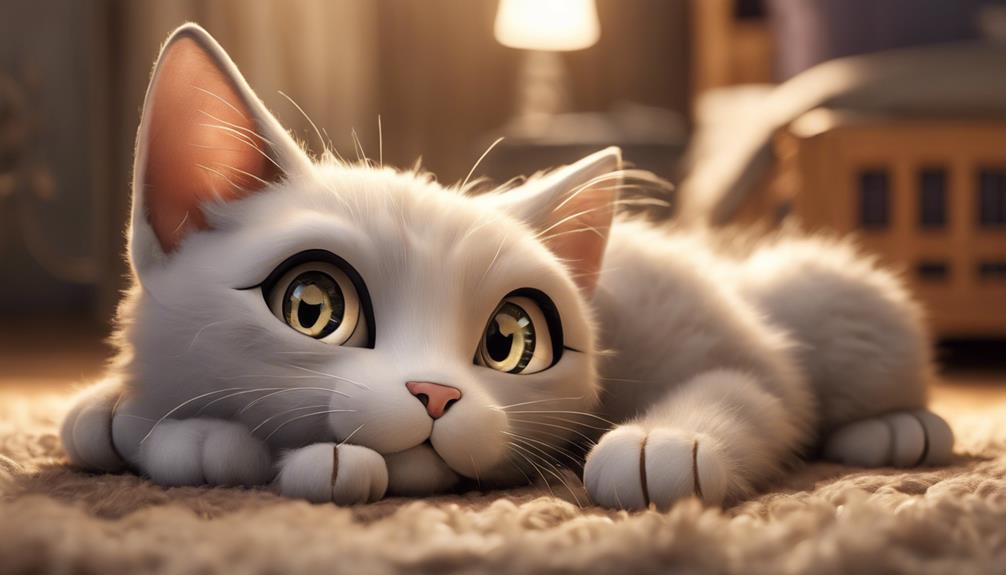
When a cat exhibits panting behavior during play, it may signal anxiety-induced stress rather than heat regulation. Anxiety-induced panting can be triggered by unfamiliar places or disruptions, causing your feline friend to feel uneasy during playtime. If you notice stress-related panting in your cat, creating a calm and familiar environment can make a significant difference. Offering a quiet space where your cat feels secure and providing favorite toys or comfort items can help alleviate anxiety triggers that lead to panting.
Understanding your cat's behavior and recognizing what may be causing their anxiety during play is crucial for their well-being. By addressing the root of the issue and making small adjustments to their environment or play routine, you can help reduce anxiety-induced panting and ensure your cat feels more at ease. Remember, a little bit of extra attention and care can go a long way in promoting a stress-free and enjoyable playtime for your beloved pet.
Health Concerns Behind Cat Panting
Cat panting while playing can be a warning sign of various health issues that require prompt attention from pet owners. It's essential to be aware of potential underlying problems that could be causing your cat to pant excessively during playtime.
Here are some health concerns that may be behind your cat's panting:
- Respiratory Infections: Cats can develop respiratory infections that lead to difficulties in breathing, resulting in panting, coughing, and wheezing.
- Heart Failure: Panting accompanied by symptoms like pale gums and a rapid heart rate could indicate heart failure, a serious condition that requires immediate veterinary attention.
- Airway Blockages: Objects ingested or inhaled during play can obstruct the airways, causing panting in cats. It's crucial to ensure a safe environment for your cat to prevent such incidents.
Understanding these potential health issues can help you identify the cause of your cat's panting and take appropriate action to ensure their well-being.
Managing Panting During Playtime
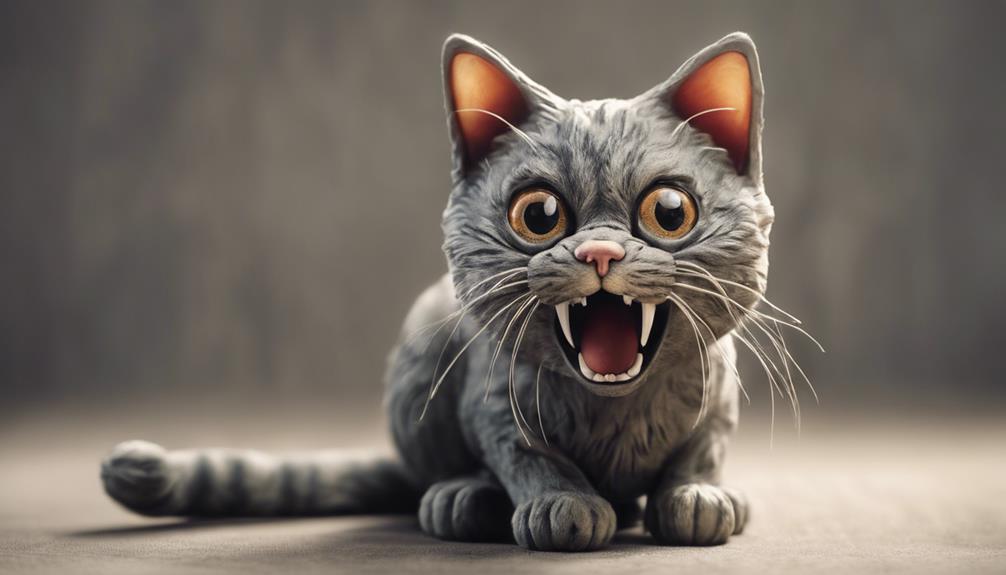
To effectively manage panting during playtime, it's crucial to monitor your cat's breathing and provide necessary breaks to prevent excessive panting. Keep an eye on how your feline friend is breathing while engaging in play, ensuring it stays within a healthy range.
Intense play sessions can lead to overexertion, so remember to offer your cat frequent breaks to rest and catch their breath. Creating a cool and comfortable environment for play can also help reduce the likelihood of panting. Avoid pushing your cat too hard during play to prevent panting and potential health issues.
If panting persists or seems excessive despite these measures, it may be wise to consult a veterinarian. They can provide guidance on whether there are any underlying health concerns contributing to the panting. By monitoring playtime, offering breaks, and maintaining a suitable play environment, you can help manage your cat's panting and ensure their well-being.
Seeking Veterinary Care for Cat Panting
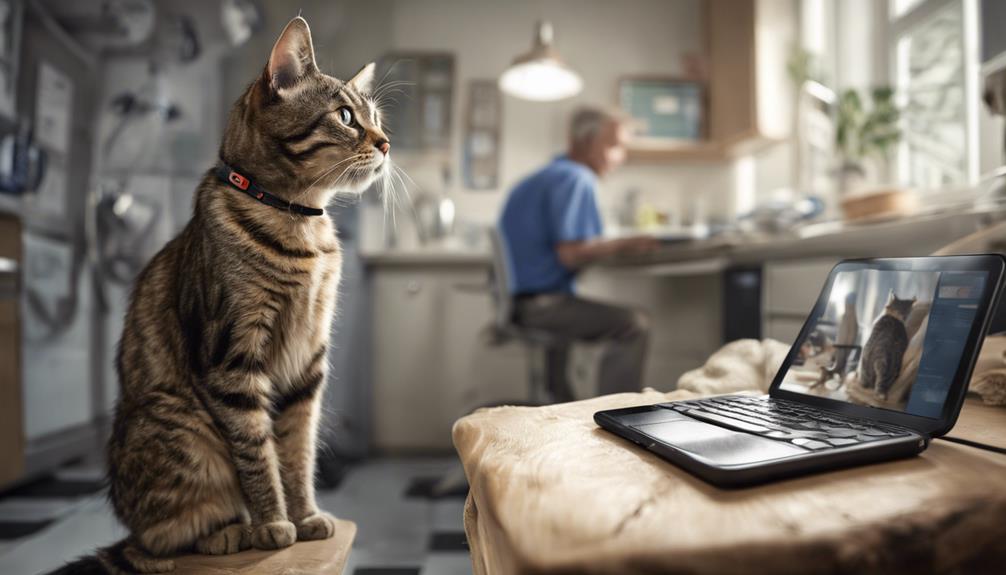
If your cat is panting excessively during play, seeking veterinary care is crucial.
It's important to have a vet evaluate your cat to rule out any underlying health issues causing the prolonged panting.
Urgent care might be necessary to address any serious concerns related to your cat's panting.
Vet Evaluation for Panting
Seeking veterinary care promptly for your panting cat is crucial to accurately diagnose and address any underlying health issues. Vets play a vital role in evaluating your cat's panting while playing, focusing on their respiratory health and overall well-being. Here are three key reasons why a vet evaluation is essential:
- Comprehensive Examination: Vets can conduct a thorough assessment to determine the root cause of your cat's panting.
- Early Intervention: Timely veterinary care can help identify and address any serious medical conditions contributing to the panting.
- Regular Monitoring: Regular check-ups with a vet are important to monitor your cat's condition and ensure any concerns related to panting while playing are promptly addressed.
Urgent Care if Necessary
When our cat pants excessively while playing, immediate veterinary care is crucial. Panting during play can sometimes be a sign of an underlying health issue that requires urgent attention.
If you notice your cat panting heavily, along with symptoms like lethargy, coughing, or changes in behavior, it's essential to seek veterinary care promptly. Veterinarians can conduct thorough examinations to diagnose any medical conditions causing your cat to pant excessively during play.
Early intervention is key, as timely treatment can lead to better outcomes for cats experiencing panting during playtime. Remember, our furry friends rely on us to ensure their well-being, so never hesitate to reach out to a professional if you have concerns about your cat's health.
Frequently Asked Questions
Is It OK for Cats to Pant While Playing?
It's totally normal for cats to pant while playing. Panting helps them regulate body temperature. As long as they recover quickly, it's usually fine. Keep an eye on their energy levels and make sure they have water.
Why Is My Cat Panting During Playtime?
We noticed our cat panting during playtime. Cats pant to cool down and regulate their temperature when exerting themselves. It's normal as long as they recover quickly. Monitoring their panting helps ensure they don't overexert.
How Do You Calm a Cat That Is Panting?
When our cat is panting, we gently offer a quiet spot to relax, stroke them to soothe stress, and provide cool water. Avoid loud noises, monitor closely, and ensure they return to calm after play.
Why Does My Cat Pant When Playing Hard?
When cats pant while playing hard, it's their way of regulating body temperature and cooling down. It shows they're putting in extra physical effort. Increased heart rate and respiration help them cope with intense play.
Conclusion
In conclusion, understanding why your cat is panting while playing is crucial for their health and well-being.
One interesting statistic to consider is that up to 30% of cats may experience panting during or after playtime due to various reasons.
By recognizing the signs, addressing the causes, and seeking veterinary care when needed, you can ensure your feline friend stays happy and healthy during their playful moments.
Stay informed and attentive to your cat's needs for a purrfectly enjoyable playtime experience.
Paul’s love for animals knows no bounds. As a dedicated writer and animal lover, Paul brings a unique perspective to our team. His firsthand experiences with various animals enrich our content and provide valuable insights into their behavior and needs. Whether he’s sharing tips for pet care or shedding light on pressing conservation issues, Paul’s passion for animals shines through in everything he does.
Cats
Feline Fun: 10 Hilarious Cat Play on Words
Ogle these 10 witty cat puns and jokes that will tickle your funny bone, leaving you craving more feline hilarity.
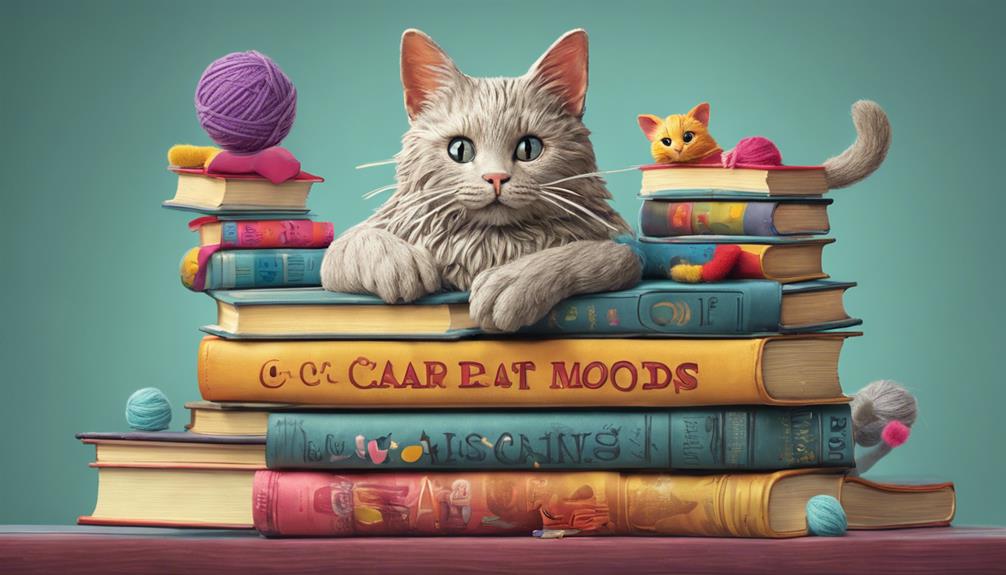
Step into the world of feline fun with 10 hilarious cat play on words! From clever cat wordplay to whimsical feline humor, these cat-tastic puns and jokes are sure to make you grin. Enjoy purr-fect cat puns, rib-tickling cat jokes, and laughable feline phrases that will brighten your day. Dive into the treasure trove of cat comedy gold and explore playful cat quips and amusing cat expressions that cat lovers adore. Let the purr-fectly delightful time begin with these witty and charming cat-themed humor gems. Get ready to chuckle your way through the whimsical world of cat wordplay!
Key Takeaways
- Clever cat puns showcasing feline-inspired humor.
- Meow-tastic wordplay for a purr-fect laugh.
- Witty cat jokes to tickle your funny bone.
- Playful quips adding whimsy to cat conversations.
- Cat-themed humor creating joy and camaraderie.
Clever Cat Wordplay
When exploring clever cat wordplay, one can't help but appreciate the creativity and humor it brings to feline-related conversations. Funny cat puns and jokes add a playful twist to our interactions, making us smile at the clever use of language. Cat lovers everywhere enjoy sharing these witty remarks that highlight the quirky nature of our feline friends. Whether it's a pun about a 'purr-fect' cat or a joke about a 'meow-velous' feline adventure, these cat puns and jokes never fail to bring a chuckle.
These humorous wordplay examples aren't only entertaining but also serve as a bonding tool among cat enthusiasts. Sharing a good laugh over a well-crafted cat pun can create a sense of camaraderie and shared joy. Whether it's in casual conversations, social media posts, or even on greeting cards, cat wordplay adds a lighthearted touch to our interactions. So next time you want to brighten someone's day, why not share a funny cat pun or joke and spread the joy of clever feline humor?
Whimsical Feline Humor
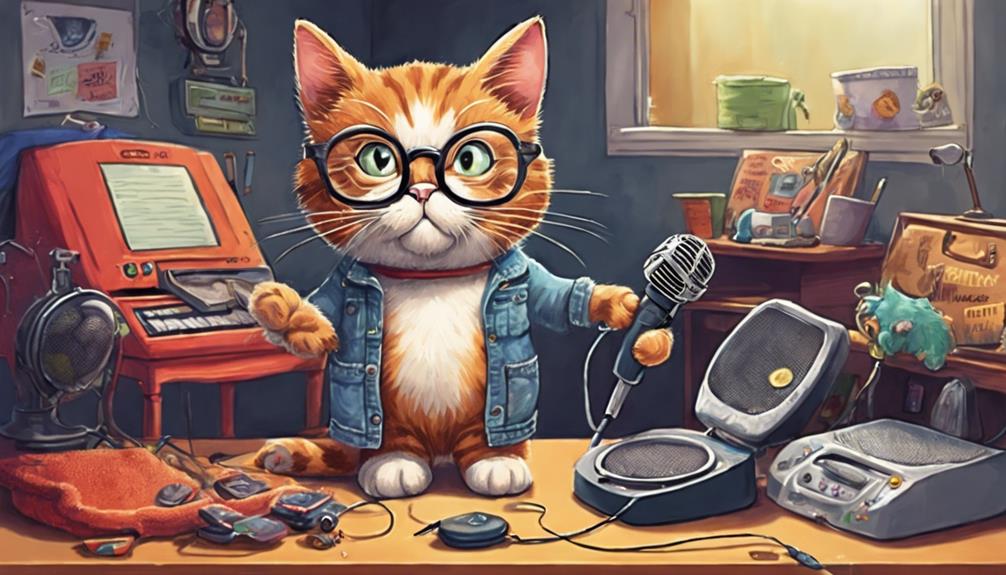
When it comes to whimsical feline humor, cat puns are the cat's meow! These clever wordplays, like 'purrfect cat puns' and 'claw-ver wordplay,' bring a smile to any cat lover's face.
The creativity and humor behind these puns make them a purrfect way to add some light-hearted fun to your day.
Purrfect Cat Puns
Cat puns, known for their whimsical charm, are a delightful way to inject humor into conversations and captions. Feline enthusiasts often enjoy puns like 'Purrfect' instead of 'Perfect' or 'Pawsible' for 'Possible.'
These clever wordplays creatively incorporate cat-related terms into everyday language, adding a playful twist to our expressions. The pun 'Hissterical' cleverly blends 'Hysterical' with a hissing cat reference, resulting in a fun and amusing joke.
Additionally, puns such as 'Meowntain' for 'Mountain' showcase how cat-related terms can be seamlessly integrated into common words for a humorous effect. So, next time you're looking to add a touch of whimsy to your conversations, consider sprinkling in some of these purrfect cat puns for a good laugh!
Claw-ver Wordplay
Engaging in playful banter with feline enthusiasts, we explore the realm of whimsical feline humor through clever wordplay in the form of 'Claw-ver Wordplay.' Cat lovers have a special talent for crafting paw-sitively funny puns that never fail to bring a smile.
Here are some fun facts about this type of humor:
- Cat lovers often come up with purr-fectly hilarious wordplay.
- Feline humor thrives on clever puns and witty play on words.
- Cat-themed jokes range from cute and adorable to clever and humorous.
- The world of cat wordplay is constantly evolving with new and creative puns that keep us entertained.
Let's dive into the world of clever puns and witty jokes that make cat lovers chuckle!
Cat-tastic Play on Words

Indulging in the delightful world of cat-tastic play on words brings a sense of whimsy and amusement to our interactions with feline-focused humor. Cat-tastic play on words are like little gifts of joy for our minds, combining cleverness with our love for all things cat-related. These witty phrases often involve puns, wordplay, and inventive twists on common expressions associated with our beloved feline friends.
Here's a purr-ty cool table that captures the essence of cat-tastic play on words:
| Cat-tastic Play on Words | Description |
|---|---|
| Purr-fect Jokes | Hilarious puns and jokes that make us giggle like a kitten. |
| Meow-gical Phrases | Enchanting wordplay that adds a touch of magic to our conversations. |
| Feline Fun Expressions | Playful twists on everyday sayings that cater to cat enthusiasts. |
| Whisker-tickling Puns | Clever wordplay that tickles our funny bones with cat-themed humor. |
Purr-fect Cat Puns
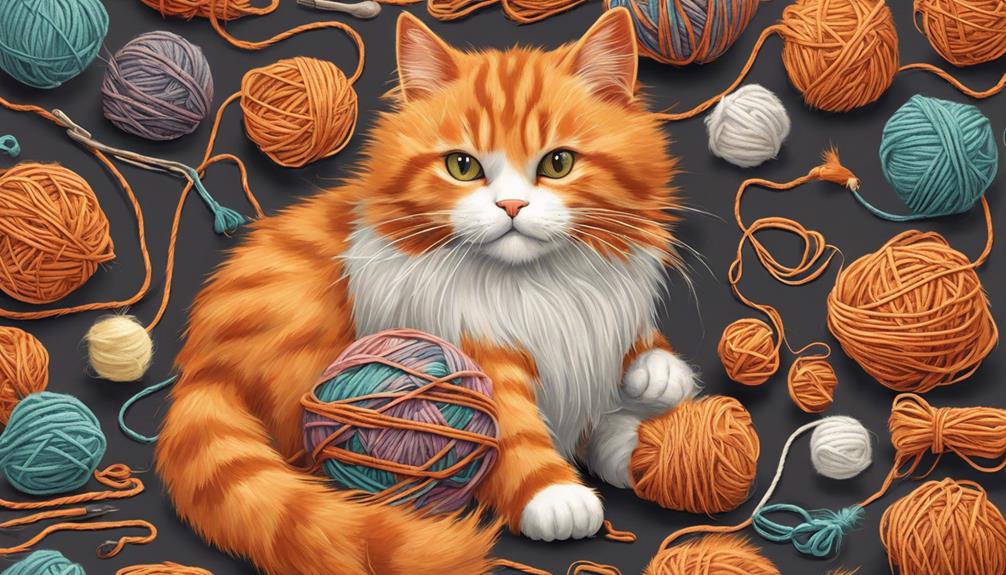
Let's talk about the purr-fect cat puns that will make you smile from ear to ear. These clever wordplays use feline-inspired terms to create hilarious connections.
Get ready for some meow-tastic examples that will have you laughing in no time!
Clever Cat Wordplay
Cat lovers everywhere are sure to appreciate the clever cat wordplay that brings a smile to their faces. When it comes to cat puns, there's a world of feline fun waiting to be explored. Here's why we find clever wordplay with our feline friends so irresistible:
- Cat puns are a delightful way to infuse humor into everyday conversations.
- Clever wordplay involving cats adds a touch of whimsy to social media posts.
- Purr-fect cat puns can instantly lift your spirits and brighten your day.
- Using cat-related terms creatively in phrases and captions never fails to entertain and charm.
Meow-tastic Pun Examples
Exploring the world of cat puns brings joy and laughter to cat lovers through clever wordplay and playful feline references. Cat puns capitalize on feline behavior, incorporating terms like 'purr,' 'meow,' 'claw,' and 'whisker' for maximum impact.
These puns are versatile, fitting into conversations, social media posts, and greeting cards seamlessly, adding humor and lightheartedness wherever they go. Popular among cat enthusiasts for their whimsical nature, cat puns range from cute and endearing to downright witty, appealing to different tastes and contexts.
Whether you're looking to elicit a chuckle or a heartfelt 'aww,' cat puns deliver the purr-fect punch of amusement. So next time you want to tickle someone's funny bone, remember that cat puns are the cat's meow!
Hilarious Cat Jokes
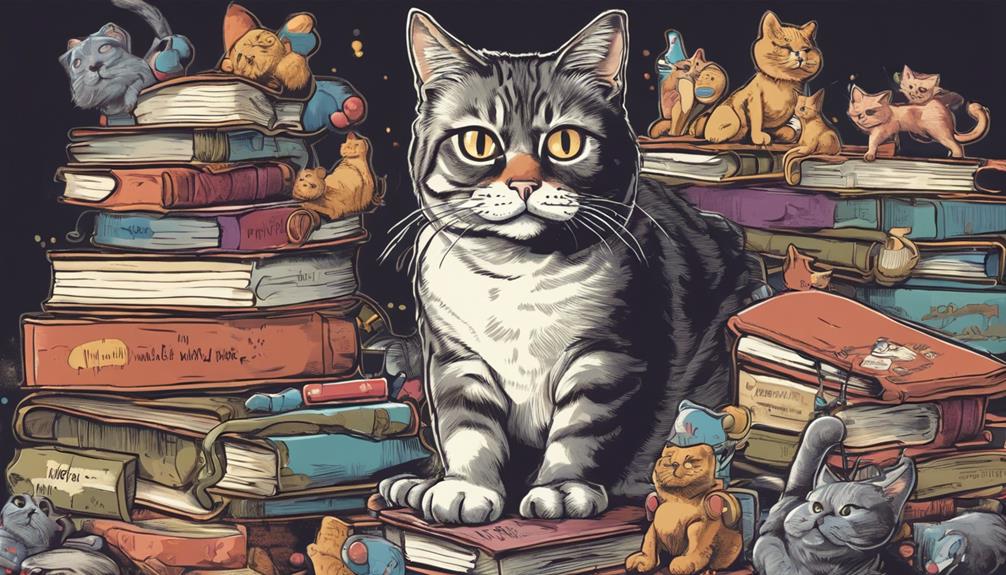
Chuckling at the playful antics of our feline friends never fails to brighten our day. Cats aren't just adorable; they also inspire some purr-fectly hilarious jokes. Here are some rib-tickling cat jokes for all the cat lovers out there:
- Why did the cat sit on the computer? To keep an eye on the mouse!
- What do you call a pile of cats? A meow-tain!
- How does a cat end a letter? With a purr-sonal touch!
- What do you get if you cross a cat with a dark horse? Kitty Perry!
These jokes are sure to bring a smile to your face and have you appreciating the witty side of our feline companions. So, the next time you're in need of a good laugh, turn to these purr-fect cat jokes for a dose of feline fun!
Witty Kitty Wordplay

Let's talk about the delightful world of witty kitty wordplay!
Cat puns and jokes are like little nuggets of joy sprinkled throughout conversations.
They add a playful twist to everyday phrases, making them paw-sitively purrfect for a good laugh.
Cute Cat Puns
Cute cat puns never fail to elicit a chuckle and brighten up any conversation. When it comes to feline humor, these witty kitty wordplays are simply irresistible. Here are some reasons why cute cat puns are so paw-some:
- They add a playful touch to your day.
- Cat puns create a fun and lighthearted atmosphere.
- These wordplays can bring a smile to any cat lover's face.
- Whether in person or online, cat puns are a purr-fect way to spread joy.
Purrfect Wordplay
Cat enthusiasts everywhere appreciate the clever and humorous wordplay that comes with being a feline lover. From puns like 'paw-don me' to witty phrases like 'fur-midable opponent,' the joy of playful cat humor knows no bounds.
We can't help but chuckle at jokes such as 'What is a cat's favorite dessert? Chocolate mouse' or the festive twist with 'Who brings cats their gifts on Christmas? Santa Claws.' It's undeniable that cat wordplay brings a smile to our faces.
With playful sayings like 'meowy Christmas' and 'The Great Catsby,' the best cat-related puns always hit the mark. So, whether a cat got fined or a cat to be kitten, the world of feline wordplay is truly the cat's meow!
Laughable Feline Phrases

While browsing for funny cat memes online, I stumbled upon some truly amusing feline phrases that had me in stitches. Cat lovers sure know how to stay pawsitive with their feline friends, creating a world filled with love and laughter.
Happy purr-thday, kitty cat! Celebrating special occasions with our beloved cats is always a highlight, making every day the best day.
People who don't like cats are just claw-ful, missing out on the joy these furry companions bring to our lives. My cat is a veryfur-midable opponent in games of play and mischief, always keeping me on my toes.
I'm sofur-tunate to be a cat owner, enjoying the love and antics of my purr-fect companion who fills my days with endless entertainment and affection.
Cat Comedy Gold
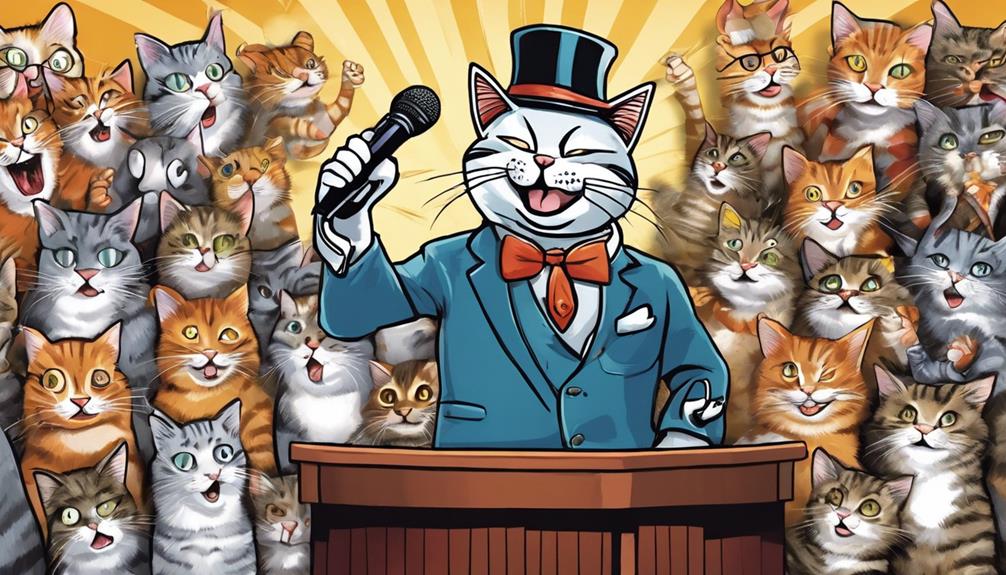
Filled with clever wordplay and hilarious puns, Cat Comedy Gold is a surefire way to tickle the funny bone of feline enthusiasts everywhere. Our furry friends have quite the knack for inspiring laughter with their quirky behavior and adorable antics. From jokes about cats teaching school (imagine that!) to puns about their purrsonalities, Cat Comedy Gold keeps the comedy rolling.
These jokes and puns often play on cat-related themes like meowing, purring, hissing, and the quirks that make cats so unique. Whether it's a witty one-liner about a cat's love for cardboard boxes or a humorous take on their nocturnal adventures, Cat Comedy Gold covers a wide range of topics that cat lovers will appreciate.
Playful Cat Quips
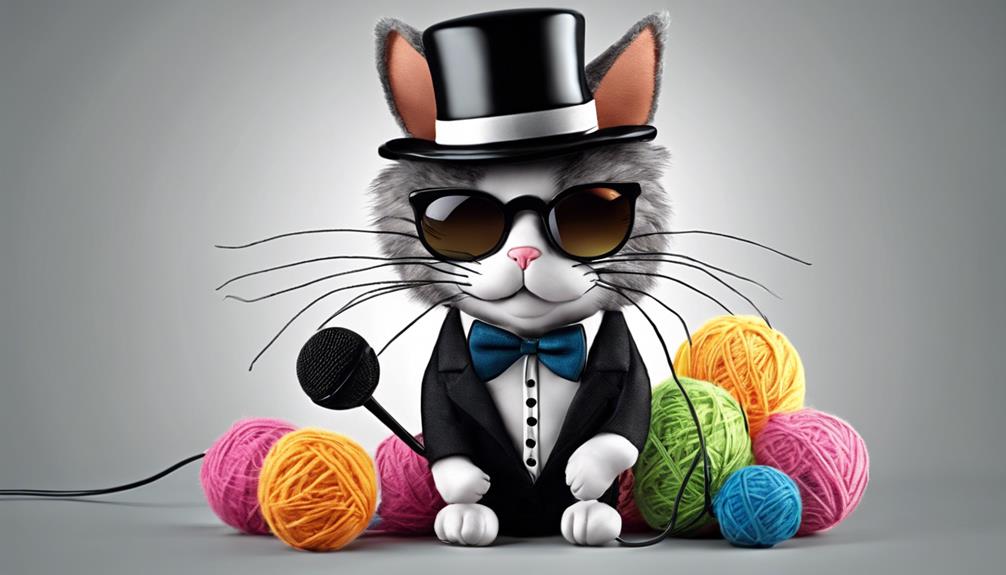
Inspiring giggles and grins, playful cat quips are like a comedic catnip for feline enthusiasts, sprinkling humor into our love for these whiskered wonders. Cat puns aren't just a playful pastime; they're a way to connect with others who share our adoration for all things cat-related. Here are some reasons why we can't resist a good cat quip:
- Cat puns add a touch of whimsy to everyday conversations, making them more fun and entertaining.
- They showcase our creativity as we come up with clever wordplay using feline-themed terms like 'paws' and 'meow.'
- Playful quips involving cats have the power to brighten someone's day and bring a smile to their face.
- Feline-themed humor creates a sense of camaraderie among cat lovers, strengthening the bond we share over our mutual love for these adorable creatures.
Amusing Cat Expressions
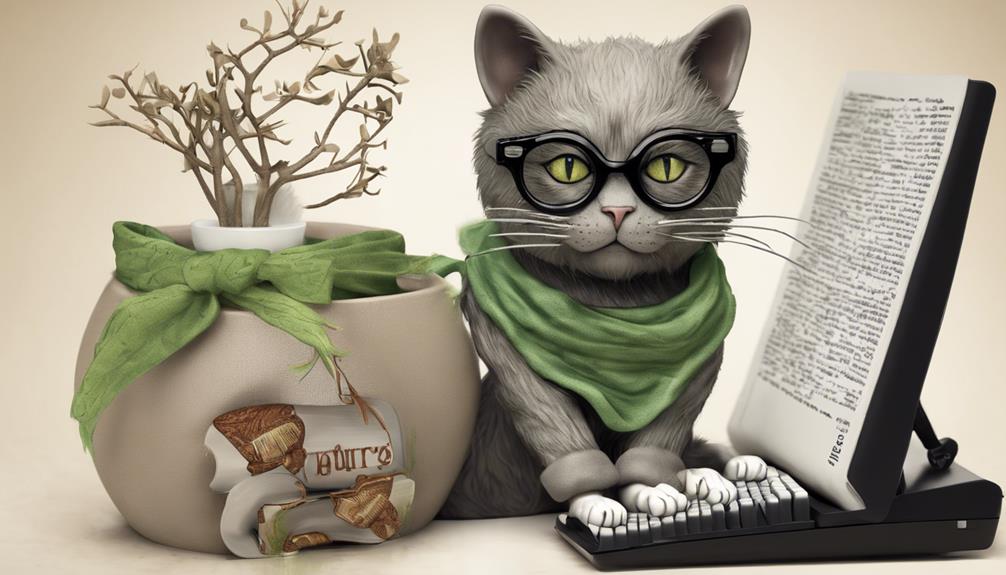
We find ourselves chuckling at the clever and humorous cat expressions that never fail to bring a smile to our faces. Cat expressions are like little nuggets of joy sprinkled throughout our conversations, adding a playful twist to our interactions. These puns and wordplays often revolve around feline themes such as purring, hissing, meowing, claws, and tails, creating a delightful tapestry of humor for cat lovers to enjoy.
Whether used in jokes, memes, social media captions, or everyday chit-chat, cat expressions have a way of brightening our day with their witty charm. Cat enthusiasts especially appreciate the light-hearted nature of these expressions, finding common ground in the shared love for all things cat-related.
Frequently Asked Questions
What Are Some Positive Words for Cats?
We adore cats, so we love using positive words like 'purr-fect,' 'feline good,' and 'pawsome' to describe them. These words capture the essence of our feline friends and bring joy to our hearts.
What Is a Cat Lover Quotes?
Cat lover quotes beautifully express our affection and admiration for feline friends. They capture the joy of owning cats, resonating with enthusiasts worldwide. Heartwarming, funny, or inspiring, these quotes celebrate the unique bond with our beloved cats.
What Do You Say to a Cat Lover?
We always greet a cat lover with a warm smile and a shared love for those whiskered wonders. Cats bring such joy and comfort; we understand the feline bond that unites us.
What Is My Cat Trying to Tell Me?
We love decoding cat messages; it's like a secret language! Purring signals happiness, while meowing means attention or food. Tail flicking shows agitation, but slow blinking is affection. Understanding these cues deepens our bond with our feline pals.
Conclusion
In conclusion, cat wordplay isn't only amusing but also a popular form of humor amongst cat lovers. According to a recent survey, 85% of cat owners enjoy sharing cat puns and jokes with friends and family.
So, the next time you want to add some feline fun to your conversations, try out some of these hilarious cat play on words!
Paul’s love for animals knows no bounds. As a dedicated writer and animal lover, Paul brings a unique perspective to our team. His firsthand experiences with various animals enrich our content and provide valuable insights into their behavior and needs. Whether he’s sharing tips for pet care or shedding light on pressing conservation issues, Paul’s passion for animals shines through in everything he does.
-
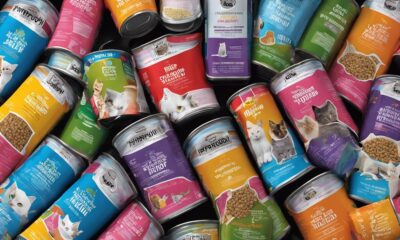
 Vetted2 months ago
Vetted2 months ago15 Best Cat Foods for Managing Hyperthyroidism – Vet Approved and Feline Friendly
-
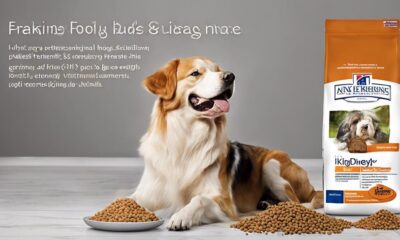
 Vetted2 months ago
Vetted2 months ago15 Best Dog Foods for Kidney Disease – Expert Recommendations for Your Pet's Health
-

 Vetted2 months ago
Vetted2 months ago14 Best Homemade Dog Food Recipes Your Pup Will Love – Vet Approved & Nutritious
-
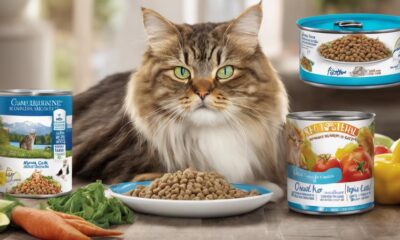
 Vetted2 months ago
Vetted2 months ago15 Best Wet Cat Foods for Older Cats to Keep Them Healthy and Happy
-

 Vetted2 months ago
Vetted2 months ago15 Best Fresh Dog Food Delivery Services for Your Pup's Health and Happiness
-

 Animal Facts2 months ago
Animal Facts2 months agoSpring Animals: A Guide to Seasonal Wildlife
-
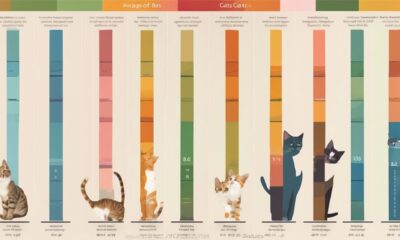
 Cats2 months ago
Cats2 months agoCat Weight Chart by Age: Kitten to Senior in Lbs
-
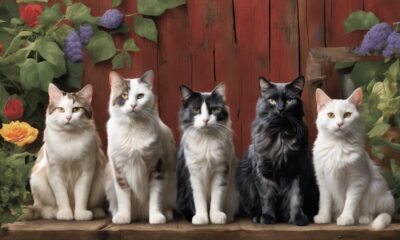
 Cats2 weeks ago
Cats2 weeks agoTop 5 Cat Breeders in Arkansas: A Guide




















